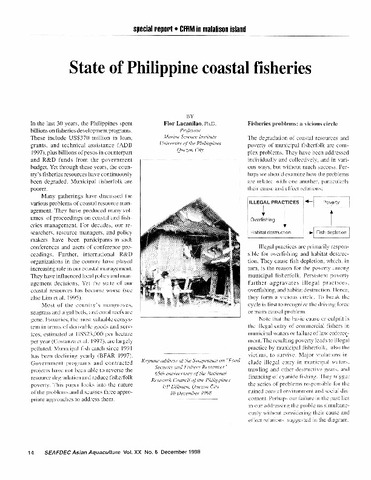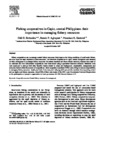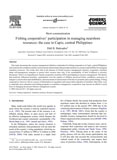Integrated water resources management: the experience of Laguna Lake Development Authority (LLDA), Philippines
- Global styles
- MLA
- Vancouver
- Elsevier - Harvard
- APA
- Help

View/
Date
2005Author
Page views
5,106ASFA keyword
AGROVOC keyword
Metadata
Show full item record
Share
Abstract
Laguna de Bay is the largest inland body of water in the Philippines and one of the largest lakes in Southeast Asia. The lake and its watershed, technically referred to as the Laguna de Bay Region or Basin, encompasses the provinces of Rizal and Laguna, portions of Cavite, Batangas and Quezon and a large portion of Metro Manila. It is a host to a total of 66 local government units (LGUs) (49 municipalities, 12 cities and five provinces) and is home to over 10 million people.
Over recent decades, uncontrolled population growth, indiscriminate deforestation and land conversion, intense fisheries, widespread industrialization, and urban sprawl have produced massive changes in the Laguna de Bay and its watershed. The resulting problems relate to solid waste management, sanitation and public health, congestion, sedimentation, unmitigated input of domestic, agricultural and industrial wastes, deteriorating water quality, flooding problems, and loss of biodiversity. The task of turning the tide of environmental degradation and of protecting and conserving the lake and its watershed for posterity calls immediate and decisive action.
Using the so-called Integrated or Basin Approach to water resources management, the Laguna Lake Development Authority (LLDA) has initiated a number of innovative actions that could spell the difference in the effort to save Laguna de Bay. These include: a) the Environmental User Fee System (EUF), a market-based instrument designed to motivate polluters to comply with effluent standards; b) Zoning and Management Plan (ZOMAP) for fish pens and fish cages; c) Shore Land Development and Management Plan (SMDP); and d) the River Rehabilitation Program.
The module for River Rehabilitation developed over seven years has produced a model for multistakeholder and community participation and involvement in the task of resource conservation and management which is gaining recognition internationally.
Suggested Citation
Carino III, J. K. (2005). Integrated water resources management: The experience of Laguna Lake Development Authority (LLDA), Philippines. In M. L. Cuvin-Aralar, R. S. Punongbayan, A. Santos-Borja, L. V. Castillo, E. V. Manalili, & M. M. Mendoza (Eds.), Proceedings of the First National Congress on Philippine Lakes (pp. 265-276). Southeast Asian Regional Center for Graduate Study and Research in Agriculture (SEARCA).
Type
Conference paperISSN
1656-8099Collections
- LakeCon2003 [49]
Related items
Showing items related by title, author, creator and subject.
-
State of Philippine coastal fisheries
Lacanilao, Flor (Aquaculture Department, Southeast Asian Fisheries Development Center, 1998) -
Fishing cooperatives in Capiz, central Philippines: their importance in managing fishery resources.
Baticados, Didi B.; Agbayani, Renato F.; Gentoral, Francisco E. (Elsevier, 1998)Fishery cooperatives can co-manage coastal fishery resources, help improve the living conditions of small-scale fishers, and slow down the rapid depletion of these resources. Ten fisherfolk cooperatives in Capiz, central ... -
Fishing cooperatives’ participation in managing nearshore resources: the case in Capiz, central Philippines
Baticados, Didi B. (Elsevier, 2004)This study documents the resource management initiatives undertaken by fishing cooperatives in Capiz, central Philippines and examines the conditions and the socioeconomic determinants that persuade members to assume ...




